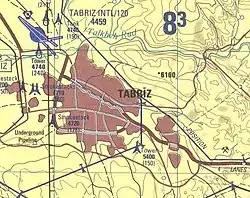38°04′36″N 46°18′36″E / 38.07667°N 46.31000°E
| Quru River | |
|---|---|
 | |
| Native name |
|
| Location | |
| Country | Iran |
| State | East Azerbaijan |
| Physical characteristics | |
| Discharge | |
| • location | Aji River |
The Quri River or Quru Chay or Quri Chay (Persian: قورو چای; Azerbaijani: Quru Çay قورو چای) is a river in East Azerbaijan province of Iran, in the endorheic basin of Lake Urmia. It originates in the mountains east of Tabriz and joins the Aji Chay just northeast of central Tabriz. The river divides Tabriz into northern and southern parts which are connected to each other by several bridges.[1] The two Ghari Bridges, beside each other, are the most famous and historic of the bridges over the river. The Sangi Bridge is also of historic interest.
The river is limited by two flood control walls and two southern and northern parkways calls Chaykenar Parkway, which almost bisect Tabriz through the middle to northern and southern half. The Chaykenar Parkways connect the most eastern and western parts of the city.
The name "Quri Chay" means "dry river", and at the end of the Twentieth Century the water, when present, was polluted and undrinkable.[2]
 Qari Bridge over Quri Chay
Qari Bridge over Quri Chay Pole-Sanghi over Quri River
Pole-Sanghi over Quri River Chay Kenar highway at night
Chay Kenar highway at night
Notes
- ↑ Werner, Christoph (2000) An Iranian town in transition: A social and economic history of the elites of Tabriz, 1747-1848 Harrassowitz, Wiesbaden, Germany, page 76, ISBN 3-447-04309-1
- ↑ Sabri-Tabrizi, Gholam-Reza (1989) Iran: A Child's Story, a Man's Experience International Publishers, New York, page 55, ISBN 0-7178-0681-2